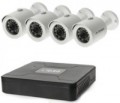Recorder
This parameter refers to the included DVR and describes the types of video signal (and therefore cameras) with which it is compatible. In some cases, the model is also indicated - for connoisseurs of the matter. So you can learn more about the capabilities of the device on specialized sources.
-
Analog. Recorders capable of working only with analog cameras, usually connected via the BNC interface (see below). The functionality of such devices is less extensive than in digital and hybrid models, but they are simple, inexpensive and quite capable of coping with basic video surveillance tasks. We also note that a modern analog recorder usually has video outputs and service interfaces in a digital format - primarily HDMI and LAN (see below).
-
Digital. Recorders designed to work with IP cameras - that is, cameras that transmit video signal through computer networks. This signal format provides improved noise immunity and a greater number of additional features compared to analog. In addition, it allows you to build video surveillance systems based on existing local networks, and cameras can be connected not only by wire, but also wirelessly (see below for more details). On the other hand, digital recorders and cameras are more expensive than analog ones, advanced functionality is not often needed in practice, and the transfer of a large number of video streams can create a high load on net
...work equipment. Therefore, it makes sense to purchase such a recorder only if the described advantages have crucial.
- Hybrid. Recorders that combine the capabilities of analog and digital models - that is, compatible with both analog and IP cameras. This combination allows you to combine the advantages of both types and partly compensate for the shortcomings, but significantly increases the price of the registrar.Max. capacity
The largest storage capacity with which the recorder is able to work normally.
The more capacious the drive, the higher the processing power of the system in which it is used should be. Therefore, any modern registrar has limitations on disk capacity. However, even in the most modest models, this figure is about 2 TB, in most cases this is quite enough to work with the capabilities provided in this particular registrar.
Camera model
A model of pointed cameras supplied with a video surveillance kit. Knowing this data, you can find detailed information on the cameras and clarify their characteristics. Also, if you buy additional cameras of the same model, you don't have to worry about compatibility.
Matrix size
The physical size of the sensor in the pointed cameras is diagonally, in inches (fractions of an inch).
The larger the sensor, the less prone it is to noise, the better image quality it can provide, and the better it is suited to low light conditions. This is due to the fact that each individual pixel gets more light, because. on a large matrix and individual dots are larger. On the other hand, large matrices are more expensive.
Number of megapixels
Sensor resolution of pointed cameras in megapixels (millions of pixels).
Higher resolution allows you to get a more detailed "picture". However, increasing the number of megapixels without increasing the sensor size can result in poor overall image quality and noise, especially in low light. Therefore, in itself, the high resolution of the matrix does not guarantee high quality shooting.
Focal length
Focal length of the lens of pointed cameras included in the set.
The focal length is the distance between the lens and the matrix, at which the image on the sensor is as clear as possible (when the lens is focused to infinity). This indicator directly affects the viewing angles and the degree of magnification: the larger the focal length, the narrower the viewing angle and the more the camera "brings" the object. At the same time, it should be noted that the actual viewing angle is determined not only by the focal length, but also by the size of the matrix (see above). In fact, this means that with different sizes of matrices, lenses with the same focal length will have different working angles. Therefore, only cameras with the same matrix size can be compared with each other according to this indicator.
Horizontal viewing angle
The viewing angle of the directional cameras supplied as standard is horizontal.
Wide viewing angles allow you to cover a large area; this is especially important given that directional cameras are often made stationary. On the other hand, all other things being equal, a larger viewing angle will mean a lower degree of magnification - objects will look smaller, detail will be worse. Therefore, when choosing according to this parameter, you should proceed from what is more important - a wide field of view or “range”.
Illumination range
The range of infrared illumination provided in the standard pointed cameras of the kit.
IR illumination allows the camera to shoot in low light conditions (up to complete darkness); at the same time, for a number of reasons, it is preferable to classical backlighting in the visible range. The backlight range is the approximate distance from the camera to the object at which it (in total darkness) will be normally visible in the frame. Note that actual visibility may vary greatly depending on the size, colour and reflectivity of specific items; Nevertheless, the claimed backlight range allows you to fairly accurately assess the "night" characteristics of the camera.
PoE power
Ability to power IP cameras from the registrar, using
PoE technology.
This technology (Power over Ethernet) allows you to supply power to external network devices over a LAN cable. Simply put, each camera will be able to receive power through the same wire through which it transmits the video signal to the recorder. This eliminates the hassle of separate power supplies. For PoE to work, it must be supported by both the recorder and the cameras; however, this is what is usually provided for in video surveillance kits.

